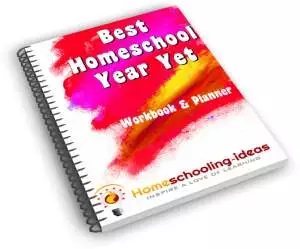Homeschool Scheduling Example
Writing a Daily Homeschool Schedule
Home >> Home School Schedule >> Homeschool Scheduling in a notebook
One way of planning your daily homeschool schedule is to just use a simple notebook.
This free-format approach really helps you capture the essence of where you want your homeschooling to go - and gives you the basis for a more formal timetable if you need one.
This type of planning would work well with the Time Out schedule and it would be great to use your Ideas Book for this.
See more Home School Schedule Examples
Sandy of Falling like Rain has written a great article about how she planned her schedule in her notebook - and has kindly given me permission to share it with you.
A Peek Inside my Planner
By Sandy Davis
Like many of you, I am in the throes of homeschool scheduling for our second semester of school. I liked the idea of a simple spiral notebook to hold my plans. Some of my homeschool scheduling this year had been complicated, and last semester was very complicated so a nice, clean, simple spiral notebook seemed just right.
I wrote on the first page,
Home Education Planner
Winter Term
2009
Don't you like that? An instantly personal planner.
I filled up the next two pages with goals, one page for each of the students I still oversee on a daily basis. The 'big kids' oversee themselves (mostly). I set goals for each of them in four areas;
Here's a sampling of our goals for this semester:
There are more, of course, but that's a sample.
I did that just to get my thinking going in the right direction. The next several pages I filled with plans for each subject. This is where I loved having a blank notebook. I just let the thoughts flow without worrying about filling in squares, counting the pages left in the curriculum or trying to fill out a scope and sequence type chart. I just put my heart on the page for each student, each subject. Sometimes I think the answers and ideas are in there, we just don't let them out.

The next two pages hold lists of things I'd like to purchase for this term and things I need to do to prepare. The former includes things like new grammar workbooks and the latter includes things like 'update reading lists for each student' and 'choose memory work'.
The next page holds pieces of our new schedule. I actually used several pages for this, as I always need a few drafts before I get it right. The complete schedule is on a form made for that, but details are in the spiral notebook.
Last semester had so many outside activities that some of us fell into less than admirable study habits. This semester we are going to remedy that by making use of Table Time. This is work we all do together at the table, so I can see that it is being done, and done well. Table Time includes things like...
Again, there is more to it, but that's a sample. I also printed a few forms and put them in the pocket of my spiral notebook.
I used attendance forms and checklists from Donna Young to help with my homeschool scheduling. Both of those forms are just to keep me on track and help me see where we're being consistent and where we're not. They also help when I'm having a bad day or a busy week and I feel like we aren't getting anything done. The checklist helps me see that we are. When you're "learning all the time" sometimes it's nice to have these reminders.
After that I made a general to-do list; get haircuts, make menus, buy a new Motivated Moms Calendar.
Homeschooling Goals
One of the things that is helping me right now is to be specific.
'Johnny will learn to read by June' is not a goal. It may be a desire, but there is no way to predict when Johnny will learn to read even if you and Johnny work very hard on it. 'Practice reading with Mom four afternoons a week' is something you can accomplish. It will be easy to tell whether you did it or not.
My list includes things like 'finish 30 pages in nature notebooks' and 'log 90 days of school by June'. That's measurable. Now, life happens, if we don't get 90 days by June we'll just add them in the summer. But, with a goal of 90 days, I will have an easier time saying 'no' to things I might be tempted to do out of the house if it means missing a day of school. I want 90 days.
Character and habit training are harder to measure, but it can be done. 'Cheerful attitude' might be subjective. 'Do not sigh or roll your eyes when Mom gives you an assignment' is specific. Either the child sighed or they didn't. 'Practice cooking skills' is a little vague. 'Learn to cook four main dishes, using Thursday afternoons to try new recipes' let's everyone know what we're doing. And, at the end of the semester, you'll know if you can cross 'four main dishes' off your to-do list or not. Specific is motivating.
So, now you've seen how I do my homeschool scheduling; goals, plans for each subject, shopping lists, to-do lists, attendance, checklists, reading lists and schedules.
What's in your planner?
Many thanks to Sandy for sharing this great insight into homeschool scheduling. If you have a story to share about how you do your planning I would love to hear from you.
See more Home School Schedule Examples
Leave Homeschool Scheduling for Homeschooling-ideas Home Page
Lovely messages sent from visitors like you:
Oh my goodness! I am a home schooling mum of 4 and I have NEVER found a better site! Thank you so much.
Blessings, Jenny (New Zealand)
I wanted to say THANK YOU for your fabulous website. I found your website, and finally I have the confidence to take the plunge and take my daughter out of school and educate her at home, thank you, thank you.
Marina (UK)
I cannot get over how much great information and super ideas you have here. Fantastic!
Ruralmama (USA)
This is simply fabulous!! I just now found this site and I'm so excited!! The opportunities and suggestions as well as the need to inspire are exactly what I have been searching to fulfill!! I'm so thrilled to get started and even more excited to continue to explore all of the fabulous suggestions and creative ideas you have offered here!!! Thank you, thank you, thank you!
Jennifer (USA)













